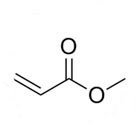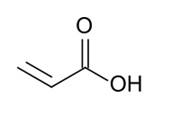Methyl Acrylate
CAS: 96-33-3
Methyl Acrylate also known as acrylic acid methyl ester, and methyl 2-propenoate is an ester of acrylic acid and has the molecular formula C4H6O2., , CAS: 96-33-3. It is a colourless, transparent liquid which has an unpleasant odour. It has a flash point of -3°C and a specific gravity of 0.954 at 20°C. It has slight solubility in water but is completely soluble in alcohols, esters, and many other organic solvents.

Methyl Acrylate Chemical Structure Composition.
Production
Methyl acrylate is made from acrylic acid. This acrylic acid is reacted with methanol, in a reactor bed at elevated temperatures, to produce methyl acrylate with water produced as a by-product.
Methyl acrylate must be stored under air to prevent polymeization.
Uses
Methyl acrylate is employed in the production of surface coatings, paper coating. Methyl acrylate provides good water resistance, low temperature flexibility, and sunlight resistance to latex paint formulations.
The leather industry uses methyl acrylate to provide different finishes to its products while the textile industry employs methyl acrylate in the manufacturing and finishing of woven and non-woven textiles.
Methyl acrylate is also utilized for adhesives and in the production of plastic film.
Methyl acrylate is also useful for water treatment as it is used to produce DMAEA (dimethylaminoethylacrylate) which is used as a flocculant in water treatment processes.
Arpadis is one of the largest chemical distributor in Europe.
Arpadis is handling the storage, transport, export & import formalities of Methyl Acrylate globally.

